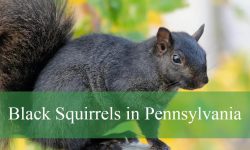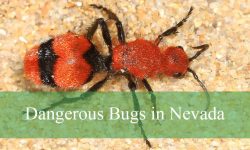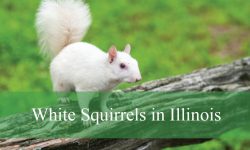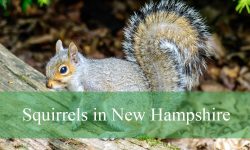Wisconsin’s wetlands, forests, and ponds are alive with the sounds of frogs calling throughout the warmer months. From the booming call of the American Bullfrog to the delicate chirp of the Spring Peeper, each species adds its own voice to the state’s natural symphony. These amphibians are among the most familiar and ecologically important creatures in the region.
Every frog species found in Wisconsin has unique features and behaviors that set it apart. Some, like the Northern Leopard Frog, move between land and water with ease, while others such as the Gray Treefrog spend much of their lives clinging to trees. Their presence reflects the health of local ecosystems, as frogs are sensitive indicators of pollution and climate change.
This guide introduces 11 types of frogs in Wisconsin, complete with identification tips, pictures, habitat information, and fascinating facts. It serves as a detailed resource for anyone interested in understanding the diversity and beauty of the state’s amphibians.
Common Types of Frogs Found in Wisconsin
American Bullfrog (Lithobates catesbeianus)
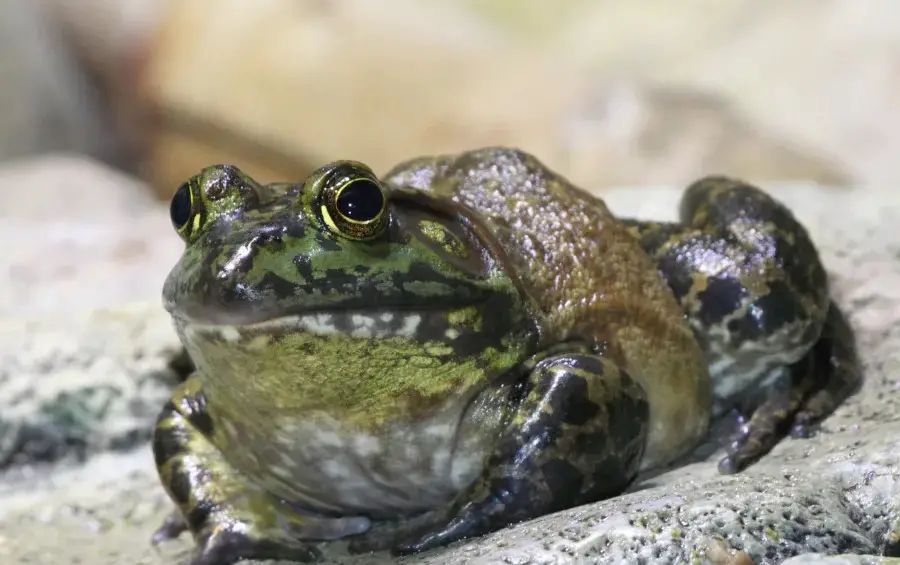
The American Bullfrog is the largest native frog species in Wisconsin, easily recognizable by its powerful legs and deep, resonant call that can carry over long distances in summer evenings. Adult bullfrogs typically measure between 3.5 and 8 inches in length, with females slightly larger than males. Their coloration ranges from green to olive-brown, often marked with darker mottling on the back and legs. The tympanum, or eardrum, is noticeably large—especially in males, where it appears larger than the eye.
Bullfrogs are semi-aquatic and prefer large, permanent bodies of water such as ponds, lakes, and slow-moving rivers. They rarely stray far from water and are excellent swimmers, using their strong hind legs to make long leaps. These frogs are mostly active from late spring through early fall and spend winter buried in mud beneath ponds or lakes. They thrive in warmer conditions and are particularly abundant in southern Wisconsin.
Their diet is remarkably diverse and opportunistic. Bullfrogs are voracious predators that consume insects, crayfish, small snakes, fish, and even other frogs. Occasionally, they may eat small birds or mammals if available. They rely on ambush tactics, remaining still until prey comes close before snapping it up with their sticky tongues. Bullfrogs play a key role in controlling insect populations but can also impact native frog species through predation.
Breeding occurs from late May to July, when males establish territories and produce deep “jug-o-rum” calls to attract females. Females lay large floating masses of eggs that may contain up to 20,000 embryos. Tadpoles take one to two years to fully metamorphose into adults, depending on temperature and food availability. Bullfrog populations remain stable across Wisconsin, though habitat loss can affect their breeding success.
Green Frog (Lithobates clamitans)
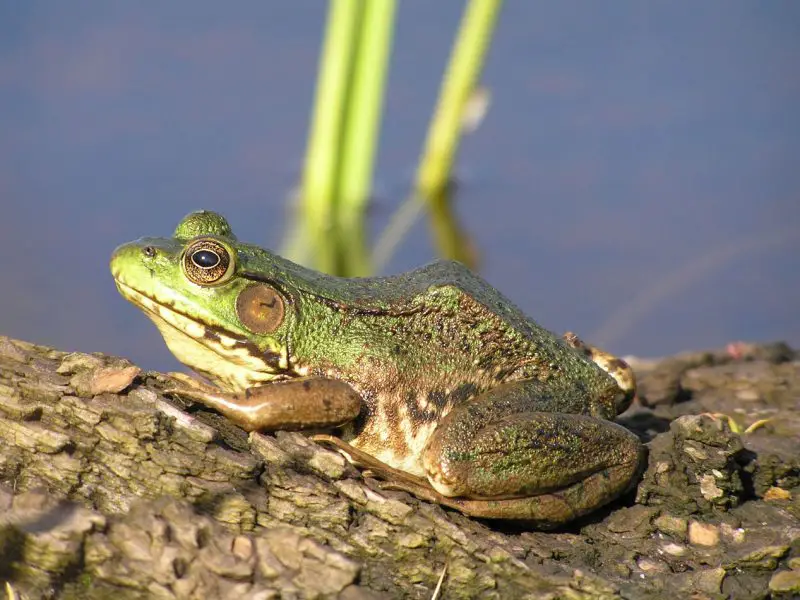
The Green Frog is a common and widespread species across Wisconsin, often mistaken for the bullfrog but noticeably smaller. Adults range from 2.5 to 4 inches long and are identified by their greenish to brown coloration, distinct dorsolateral ridges running along the back, and the characteristic twang-like call that resembles a plucked banjo string. Males typically have a yellowish throat, which becomes more vibrant during the breeding season.
This species inhabits a wide range of freshwater environments including ponds, lakes, marshes, and slow streams. Green Frogs prefer areas with abundant vegetation along the water’s edge, where they can bask or ambush prey. They are also semi-terrestrial and may hop short distances away from water during cool or wet conditions. During winter, they hibernate underwater, burying themselves in mud or under vegetation to survive the cold months.
Green Frogs are carnivorous and primarily feed on insects such as beetles, flies, and crickets, as well as small crustaceans and snails. They capture prey using their long, sticky tongues and rely heavily on their vision to detect movement. Tadpoles graze on algae and detritus before transforming into juvenile frogs after one or two summers.
Breeding takes place between late May and August. Males call from shallow water to attract females, and after mating, females lay up to 4,000 eggs in clusters attached to aquatic plants. The eggs hatch within a week, and tadpoles develop through summer and overwinter before becoming froglets. The Green Frog’s adaptability and tolerance for human-altered habitats make it one of Wisconsin’s most frequently encountered amphibians.
Northern Leopard Frog (Lithobates pipiens)
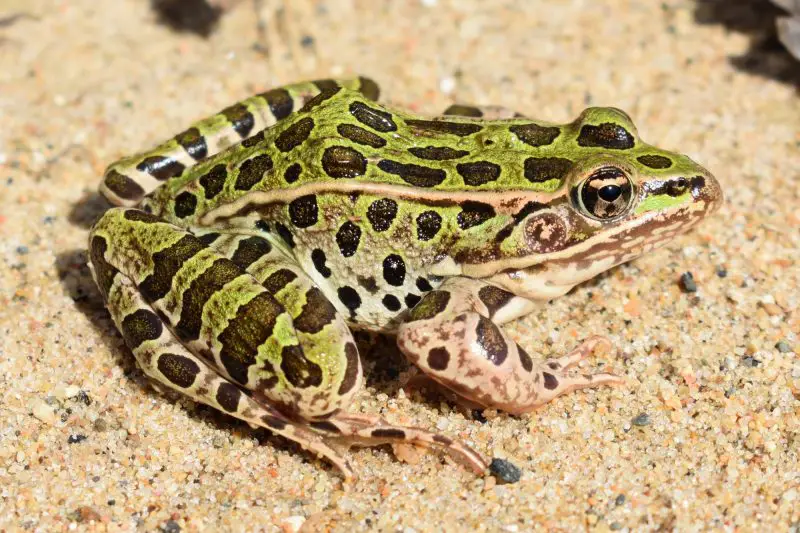
The Northern Leopard Frog is one of Wisconsin’s most striking amphibians, named for its pattern of dark, rounded spots outlined by light borders across its back and legs. Adults typically measure 2 to 4.5 inches long and display color variations from bright green to brownish olive. Their smooth skin and prominent dorsolateral ridges help differentiate them from similar species. The frog’s call resembles a low snore followed by chuckling grunts.
This species prefers open, grassy wetlands, meadows, and the edges of ponds and streams. Unlike many other frogs, Northern Leopard Frogs often move considerable distances from water during summer, especially after breeding. They rely on both aquatic and terrestrial habitats for survival and hibernate underwater or in damp soil during winter.
Northern Leopard Frogs are opportunistic feeders, consuming a variety of insects, spiders, slugs, and small invertebrates. They are active both day and night, using a quick tongue strike to capture prey. Because of their sensitivity to environmental changes, they are considered good indicators of ecosystem health, and their populations can decline rapidly due to habitat loss or pollution.
Breeding begins in early spring, often as soon as ice melts from ponds. Males call in shallow water to attract females, and mating occurs from late March to early May. Females lay large egg masses containing several thousand eggs, which hatch within two weeks. Tadpoles metamorphose in midsummer, and juveniles often disperse into surrounding grassy fields. Northern Leopard Frogs are still found throughout Wisconsin, though their numbers have decreased in some regions due to habitat degradation.
Pickerel Frog (Lithobates palustris)
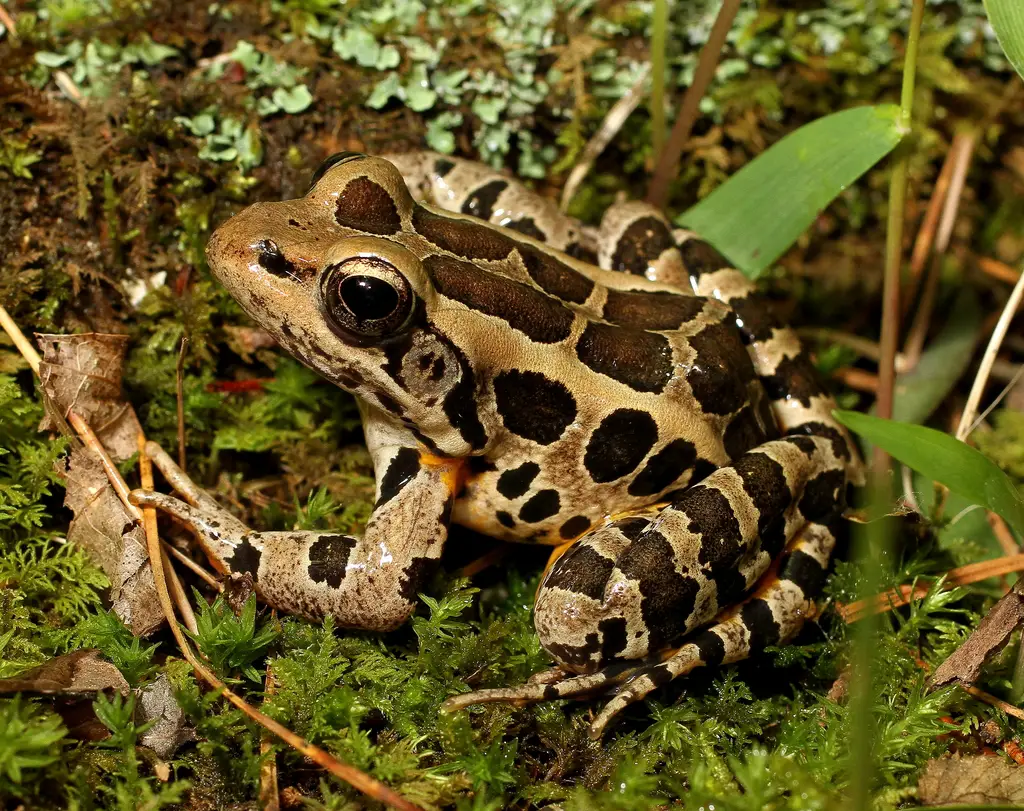
The Pickerel Frog is a medium-sized frog known for its square-shaped dark spots arranged in neat rows along its back. Adults typically grow between 2 and 3.5 inches in length and exhibit shades of tan or light brown with bright yellow or orange coloration on the inner thighs—a warning to predators of their mild skin toxins. Their smooth skin and symmetrical markings make them relatively easy to identify among Wisconsin’s frog species.
These frogs prefer cool, clear water habitats such as streams, springs, and marshes, particularly in wooded or grassy areas. They are more sensitive to pollution and siltation than many other species, making them good indicators of clean aquatic environments. During summer, Pickerel Frogs may be found on land in damp meadows or near shaded ponds. In winter, they hibernate underwater or in muddy burrows near streambeds.
Pickerel Frogs are carnivorous and feed mainly on insects, spiders, and small crustaceans. They hunt primarily at night, using their excellent vision to detect prey movement. Unlike the similar Northern Leopard Frog, the Pickerel Frog’s toxins deter many predators, including fish, though some species like garter snakes can safely eat them.
Breeding occurs in early spring, often in April or May, when males call with a low, snore-like sound to attract females. Females lay egg masses of up to 3,000 eggs in shallow water attached to submerged vegetation. Tadpoles hatch within one to two weeks and typically metamorphose by midsummer. Pickerel Frogs remain relatively uncommon but stable in Wisconsin, most often found in northern and central regions with unpolluted water sources.
Mink Frog (Lithobates septentrionalis)
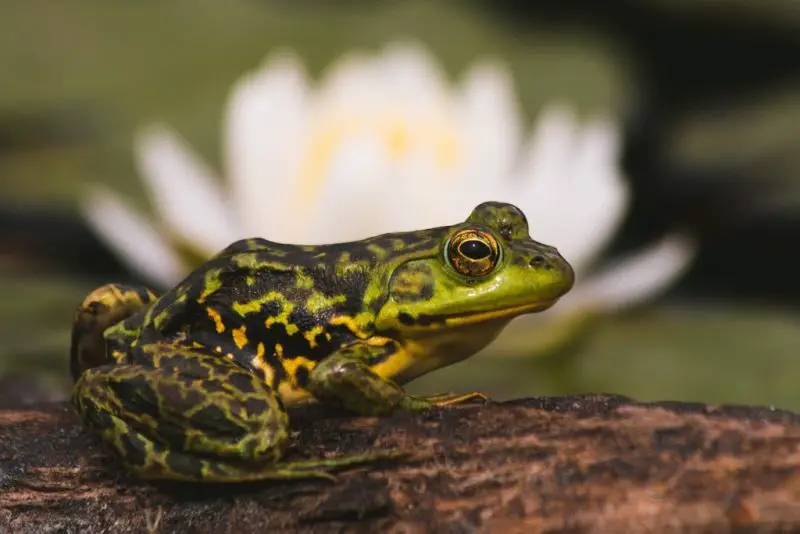
The Mink Frog is a northern species found mainly in Wisconsin’s cooler lakes and ponds, particularly in the northern part of the state. It earns its name from the musky, mink-like odor it produces when handled. Adults measure between 2 and 3 inches in length and are olive-green or brown with dark irregular spots on their backs and legs. Their skin is rougher than most other frogs, and males can be distinguished by their large eardrums and yellow throats.
Mink Frogs are highly aquatic and rarely stray far from water. They prefer cold, clear lakes, bogs, and ponds with abundant vegetation, often sharing habitats with the Green Frog. These frogs are primarily active at night and are known for their distinctive rapid, repetitive call that sounds like tapping or hammering metal. During the harsh Wisconsin winters, they hibernate beneath the muddy bottoms of lakes and ponds.
Their diet consists mostly of aquatic insects, larvae, spiders, and small crustaceans. Mink Frogs are sit-and-wait predators, staying motionless until prey passes within striking distance. They are well adapted to their watery habitats, using strong hind legs for swimming and leaping among floating vegetation.
Breeding begins in early summer, typically in June or July. Males call from open water, and females lay large clusters of eggs that float near the surface. The eggs hatch in about a week, and tadpoles may overwinter before completing metamorphosis the following year. Due to their preference for pristine, cold-water habitats, Mink Frogs are considered a northern specialty and are rarely found in southern Wisconsin.
Wood Frog (Lithobates sylvaticus)
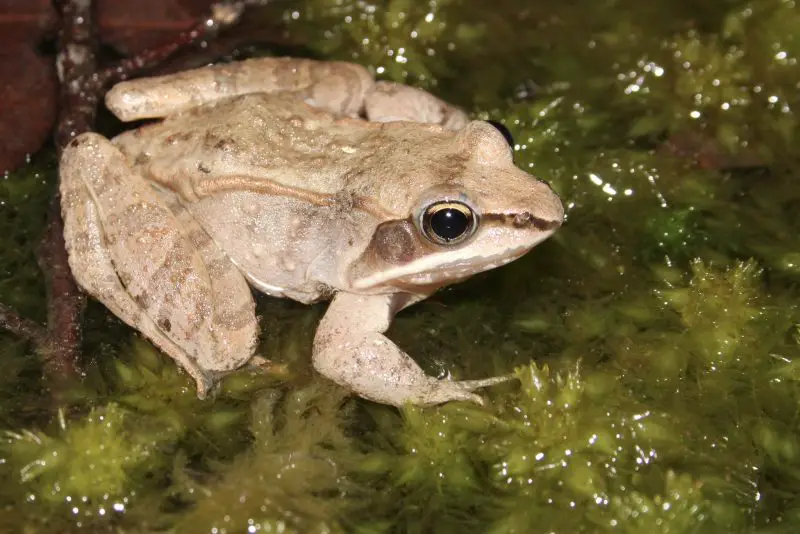
The Wood Frog is one of Wisconsin’s most remarkable amphibians, well known for its ability to survive extreme cold. Adults measure between 1.5 and 3 inches in length and are typically tan, brown, or reddish, with a distinctive dark mask running from the snout through the eyes to the eardrums. Their smooth skin and prominent dorsolateral ridges make them easy to distinguish from similar species. Despite their modest appearance, Wood Frogs are the only frogs found north of the Arctic Circle.
This species thrives in moist forests, wooded swamps, and near temporary pools. In Wisconsin, they are most abundant in northern and central woodlands. Wood Frogs are among the earliest breeders in spring, often emerging while snow is still melting. They hibernate on land beneath leaves and soil, where they can survive being partially frozen due to natural antifreeze compounds in their bodies.
Wood Frogs feed on a wide variety of small invertebrates such as insects, spiders, and worms. They hunt primarily on land, usually at dawn or dusk, relying on their keen eyesight to detect prey movement. Tadpoles, on the other hand, graze on algae and detritus in shallow pools until metamorphosis.
Breeding takes place from March to early May, depending on weather conditions. Males gather in temporary pools and call with short, duck-like quacks to attract females. Females lay masses of 1,000–3,000 eggs, often communally attached to submerged branches. Tadpoles develop rapidly before the ponds dry up, transforming into juveniles within two months. Wood Frogs play a vital ecological role in forest ecosystems and are considered an indicator of healthy woodland wetlands.
Spring Peeper (Pseudacris crucifer)
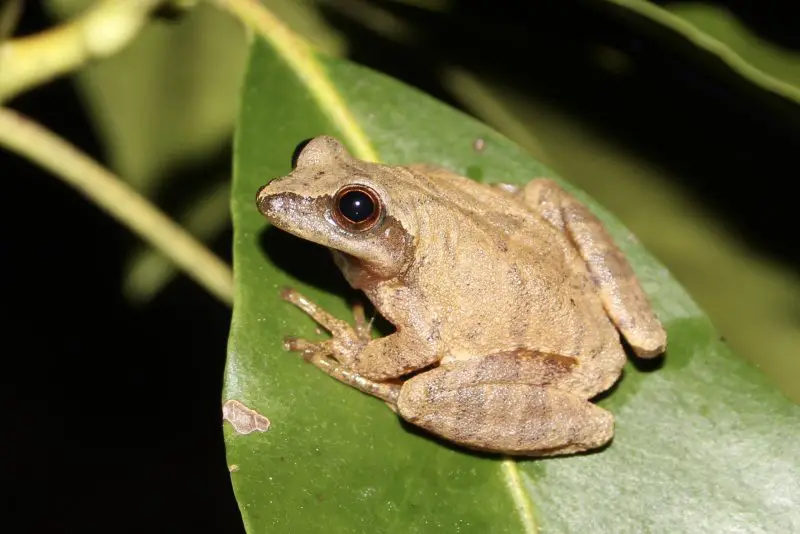
The Spring Peeper is one of Wisconsin’s smallest and most familiar frogs, famous for its high-pitched, bell-like chorus that signals the arrival of spring. Adults measure only about 1 to 1.5 inches long and are light tan to gray with a distinctive dark “X” pattern on their backs. Their small size, rounded bodies, and sticky toe pads make them well adapted to climbing through vegetation.
Spring Peepers inhabit moist forests, wooded swamps, and areas near ponds and marshes. They spend much of their time hidden under leaves or vegetation during the day, becoming active at dusk and night. Despite their tiny size, their loud calls can be heard from long distances in early spring, often forming large choruses around breeding ponds. In winter, they survive by freezing solid and thawing again in spring, much like the Wood Frog.
These frogs feed on small insects, ants, flies, and spiders. They are ambush predators, sitting quietly until prey comes close enough to capture with a quick flick of the tongue. Spring Peepers play a significant role in controlling insect populations in forest ecosystems.
Breeding begins as early as late March and peaks in April. Males call persistently from shallow ponds and flooded ditches to attract females. Females deposit up to 1,000 eggs singly or in small clusters on underwater plants. Tadpoles hatch within a week and metamorphose into froglets by early summer. Spring Peepers are widespread throughout Wisconsin and are an essential part of the early spring soundscape.
Western Chorus Frog (Pseudacris triseriata)
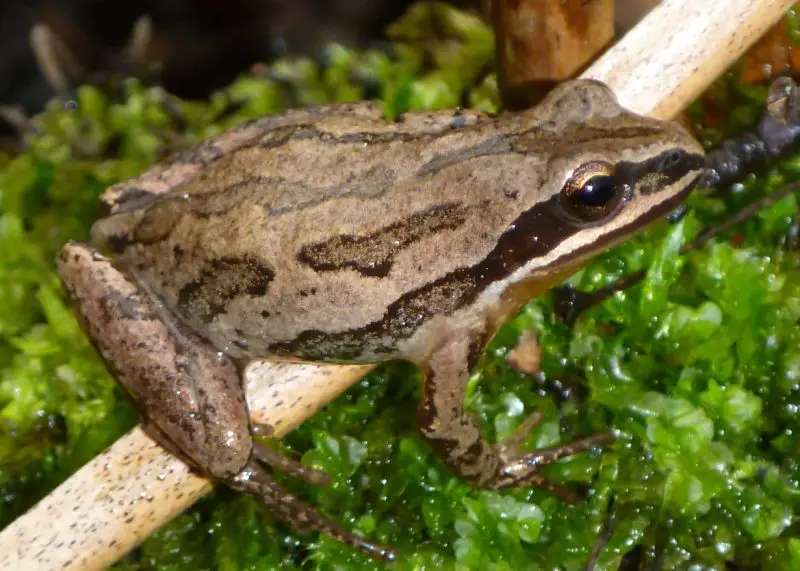
The Western Chorus Frog is a small, secretive amphibian found in southern and central Wisconsin. Adults measure about 1 to 1.5 inches long and are light brown, olive, or gray with three dark stripes running down their backs. Their smooth skin and pale undersides help them blend into grassy and muddy habitats. Their call—a rapid, rising “creeeek” that sounds like a thumb running along a comb—is one of the first frog sounds heard each spring.
These frogs favor open habitats such as meadows, wetlands, flooded fields, and ditches, especially near shallow, temporary ponds. They are active mainly at night and spend much of the day hiding under vegetation or debris to avoid predators. Western Chorus Frogs are highly adaptable and can survive in both rural and suburban areas if breeding sites remain available.
Their diet includes small insects, ants, beetles, and spiders. They are quick hunters that rely on movement detection to capture prey. Tadpoles feed primarily on algae and organic detritus, contributing to nutrient cycling in shallow wetlands.
Breeding begins very early in the season, often before other frog species start calling. Males gather in shallow water and produce their distinctive comb-like trills to attract females. Females lay clusters of 500–1,500 eggs attached to submerged vegetation. Tadpoles hatch within days and transform into small frogs by midsummer. Although abundant, Western Chorus Frogs face threats from habitat loss and water pollution, which can affect their breeding success.
Boreal Chorus Frog (Pseudacris maculata)
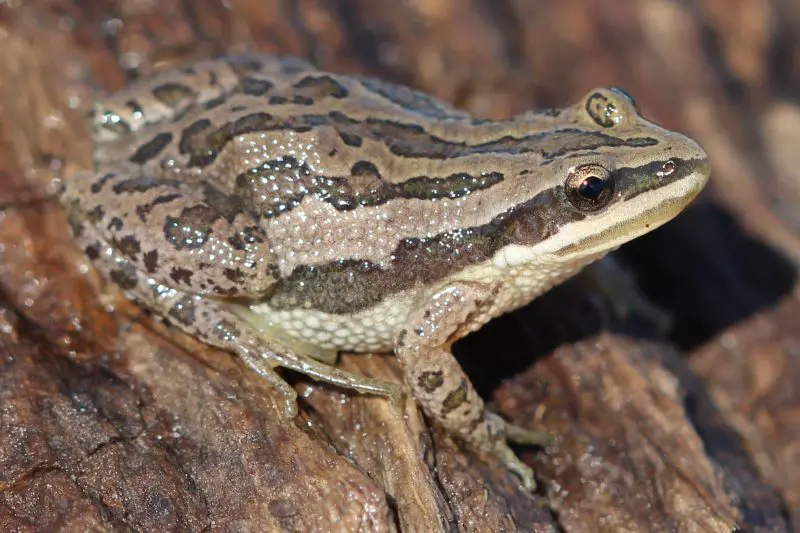
The Boreal Chorus Frog is closely related to the Western Chorus Frog but occurs mainly in northern Wisconsin. Adults are tiny, measuring just over an inch long, and their coloration ranges from tan to brown or olive with three broken dark stripes along the back. A light line often runs from the snout to the side of the body, helping distinguish them from other chorus frogs. Their call is similar to the Western Chorus Frog but shorter and more variable in tone.
This species inhabits boreal forests, marshes, and open wetlands with shallow, temporary water. They are highly cold-tolerant and among the first amphibians to emerge after the snow melts. Boreal Chorus Frogs spend much of the year on land, hiding under moss, logs, or leaf litter, and return to water only for breeding. Their ability to survive harsh northern climates makes them one of Wisconsin’s hardiest amphibians.
Boreal Chorus Frogs feed mainly on small invertebrates such as ants, gnats, and small beetles. Their feeding activity increases during warm, humid nights when insects are most abundant. Tadpoles consume algae and decomposing plant matter in shallow pools, helping maintain the health of wetland ecosystems.
Breeding occurs in early spring from April to early May. Males produce a short, rasping trill to attract females. Females lay small clusters of eggs that hatch quickly, often within a week. Tadpoles develop rapidly to take advantage of temporary water before it evaporates. The Boreal Chorus Frog is widespread in northern Wisconsin but remains elusive due to its small size and short breeding period.
Cope’s Gray Treefrog (Dryophytes chrysoscelis)
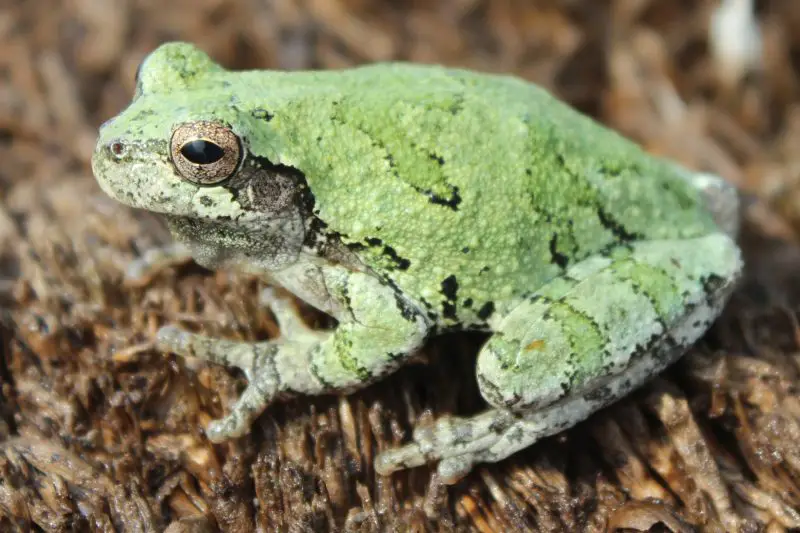
Cope’s Gray Treefrog is a small, arboreal species found throughout Wisconsin, particularly in forests and wooded suburbs. Adults measure 1.25 to 2 inches long and have rough, warty skin that changes color from gray to green depending on temperature and surroundings. They are nearly identical to the Gray Treefrog but can be distinguished by their faster, higher-pitched call. Both species display bright orange or yellow patches on their inner thighs, visible when they leap.
These frogs spend much of their lives in trees, shrubs, and tall vegetation near wetlands or ponds. They are nocturnal and most active on warm, humid nights, especially during the breeding season. Their large toe pads allow them to cling to leaves, bark, and even glass surfaces. In winter, Cope’s Gray Treefrogs survive freezing conditions by producing glycerol-based antifreeze compounds in their bodies.
They are insectivorous and feed on moths, beetles, and other small invertebrates. Cope’s Gray Treefrogs use a sit-and-wait strategy, remaining motionless until prey moves within striking distance. Their activity helps control insect populations in both forest and suburban areas.
Breeding occurs from late May through July. Males call from trees or vegetation near ponds, producing rapid trills to attract females. Females lay clusters of eggs attached to submerged vegetation. Tadpoles hatch within days and metamorphose into young frogs by midsummer. This species thrives in a range of habitats and adapts well to human presence, provided suitable breeding waters are available.
Gray Treefrog (Dryophytes versicolor)
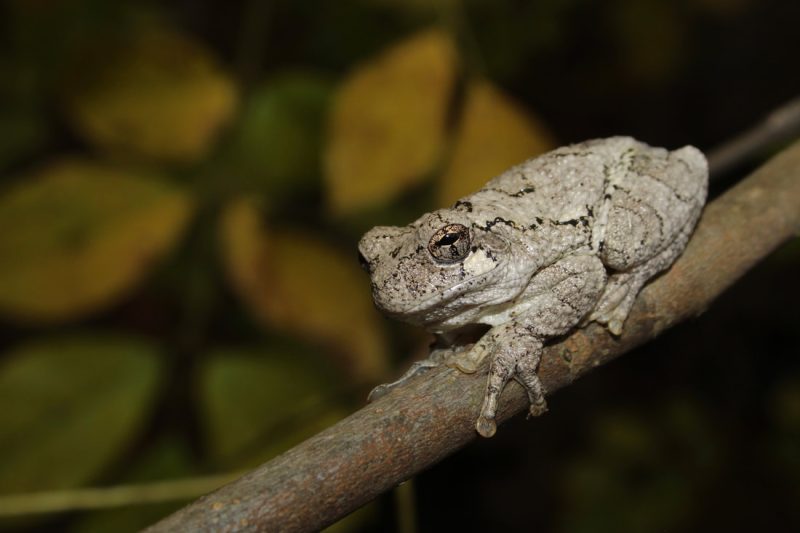
The Gray Treefrog closely resembles Cope’s Gray Treefrog but differs in its slower, more musical trill. Adults range from 1.25 to 2 inches long with rough skin that can shift between gray, green, and brown shades to match their surroundings. Like Cope’s, they display bright yellow-orange inner thighs that act as a warning signal to predators when leaping. Their camouflage and nocturnal habits make them difficult to spot during the day.
Gray Treefrogs inhabit mixed forests, woodlots, and suburban areas with nearby ponds or wetlands. They spend most of their time high in trees or shrubs but descend to ground level during breeding. They are most active during warm, humid evenings in late spring and summer. During cold months, they can survive partial freezing, a remarkable adaptation shared with other northern amphibians.
Their diet consists of insects, spiders, and other small invertebrates, which they capture with quick tongue flicks. Gray Treefrogs play an important ecological role in controlling pest populations and are often found near outdoor lights where insects gather. Tadpoles feed on algae and organic matter before metamorphosing into froglets.
Breeding occurs from late May to early August. Males call from vegetation near ponds or temporary pools, creating choruses that fill the night air. Females lay small clusters of eggs attached to aquatic plants. The tadpoles grow rapidly, developing into young frogs within one or two months. Gray Treefrogs remain widespread across Wisconsin, especially in wooded regions, and are a familiar sound during summer nights.
Tips for Identifying and Observing Frogs in Wisconsin
Learn the Calls
Each frog species in Wisconsin has a distinct call, which is often the easiest way to identify them—especially during breeding season. The Spring Peeper’s high-pitched “peep,” the Western Chorus Frog’s comb-like trill, and the American Bullfrog’s deep “jug-o-rum” call are unmistakable. Carrying a field guide or using a frog-call identification app can help you learn to recognize each species by sound.
Observe During Breeding Season
The best time to observe frogs is from early spring through mid-summer when males are actively calling to attract mates. Visiting wetlands, ponds, or shallow marshes at dusk or after rain increases your chances of spotting multiple species. Bring a flashlight with a red filter to avoid startling them while observing at night.
Look for Key Physical Traits
Pay attention to color, size, and markings. Wood Frogs have a distinct black mask; Northern Leopard Frogs show round, dark spots; Pickerel Frogs display square spots in neat rows. Treefrogs like the Gray Treefrog and Cope’s Gray Treefrog can change color between green and gray, while Green Frogs have prominent dorsolateral ridges along their backs.
Respect Their Habitat
Avoid handling frogs excessively, as their skin is sensitive and easily absorbs oils or chemicals from human hands. If you must move one for safety, make sure your hands are wet and clean. Never remove frogs or tadpoles from the wild—it disrupts ecosystems and may be illegal in certain protected areas of Wisconsin.
Encourage Frogs in Your Yard
Create a frog-friendly environment by adding a small pond with shallow edges, native plants, and no fish. Avoid pesticides or herbicides, as these chemicals can harm amphibians. Providing natural shelter, such as rocks, logs, and leaf litter, will encourage frogs to breed and feed in your garden.
FAQs about Frogs in Wisconsin
What is the most common frog in Wisconsin?
The Green Frog and Northern Leopard Frog are among the most common species in Wisconsin. They thrive in a wide range of freshwater habitats and are often seen or heard near ponds, lakes, and marshes throughout the state.
When do frogs come out in Wisconsin?
Frogs typically emerge in late March or early April, depending on temperature and snowmelt. Early breeders such as Wood Frogs, Spring Peepers, and Chorus Frogs are often active while ice still lingers on ponds.
How many frog species live in Wisconsin?
Wisconsin is home to 11 frog species, including both aquatic and tree-dwelling types. These include the American Bullfrog, Green Frog, Northern Leopard Frog, Pickerel Frog, Mink Frog, Wood Frog, Spring Peeper, Western Chorus Frog, Boreal Chorus Frog, Gray Treefrog, and Cope’s Gray Treefrog.
Do frogs hibernate in Wisconsin?
Yes. Most Wisconsin frogs hibernate through winter, either underwater or beneath soil and leaf litter. Aquatic species like Bullfrogs and Green Frogs overwinter in the mud at the bottom of ponds, while terrestrial species like Wood Frogs freeze partially and survive until spring thaw.
Are any frogs in Wisconsin poisonous?
While none are dangerous to humans, the Pickerel Frog secretes mild toxins from its skin that can irritate predators or sensitive human skin. It’s best to admire frogs without handling them unnecessarily.
When can I hear frog calls in Wisconsin?
Frog calls typically begin in early spring and continue through midsummer. Chorus Frogs and Wood Frogs call in March and April, while Bullfrogs and Green Frogs sing later from June through August.
What do frogs in Wisconsin eat?
Adult frogs feed primarily on insects, spiders, worms, and small invertebrates. Larger species like Bullfrogs may eat small fish or even other frogs. Tadpoles mostly consume algae and organic matter in the water before metamorphosis.
How can I help protect frogs in Wisconsin?
You can help by preserving natural wetlands, reducing pesticide use, and supporting native vegetation around ponds and lakes. Reporting frog observations to local wildlife agencies also contributes to conservation data and helps track population health.

